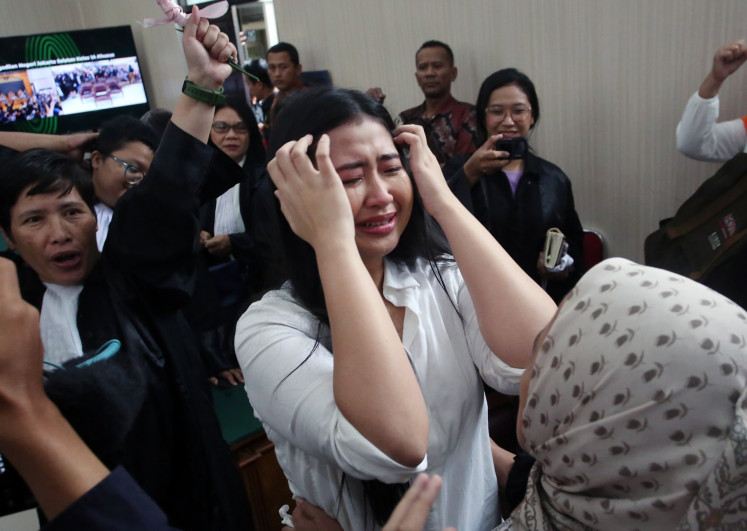Popular Reads
Top Results
Can't find what you're looking for?
View all search resultsPopular Reads
Top Results
Can't find what you're looking for?
View all search resultsA harp delight from Aula Simfonia
When Jakarta’s traffic was reduced to almost a standstill due to a sudden thunderstorm, another storm was taking place at Aula Simfonia Jakarta
Change text size
Gift Premium Articles
to Anyone
W
hen Jakarta’s traffic was reduced to almost a standstill due to a sudden thunderstorm, another storm was taking place at Aula Simfonia Jakarta.
This storm was thunderous but pleasing, as the thunder came from a harp and a full orchestra in a brand new, beautifully crafted concert hall: Aula Simfonia Jakarta
Located in Kemayoran area, this hall is declared by Addie M.S., the director of Twilite Orchestra, as “one of few international-standard concert halls in Jakarta”. Designed and built by Rev. Dr. Stephen Tong, this hall has placed Jakarta among great world cities with a representative concert hall, a long overdue necessity.
The first impression of the concert hall reminds one of the Brahms Saal in Musikvereingebäude (Musical Society of Austria), Vienna, with a beautiful line-up of pipe organ and paintings of famous composers on the wall. It has beautiful lighting and an excellent seating arrangement complete with balconies.
This time, the honor of testing the acoustics of the hall belongs to Rama Widi, a young and talented Indonesian harpist, performing with Twilite Orchestra on Aug. 6. Starting at 7:30 p.m., the concert features four orchestral works and two solo harp performances.
The orchestral works are Overture from Die Fledermaus by Johann Strauss Jr, Act. 1 from Gunung Agung (Dari Gunung Agung), a world premiere by Indonesia’s own Trisutji Kamal, intermezzo from “Cavalleria Rusticana” by Pietro Mascagni, and “Harp Concerto Op. 25” by Alberto Ginastera. Paragita Choir, with Aning Katamsi as soprano, performed the vocal works of Kamal’s composition. Two solo harp works, Song In The Night by Carlos Salzedo and Une Chatelaine En Sa Tour by Gabriel Faure, were performed by Rama Widi.
As the music starts, the true power of a “real” concert hall emerged. The acoustic quality of the hall burnished the performance of Twilite Orchestra, echoing every note perfectly. Strauss Jr.’s Die Fledermaus flows like a gentle stream, pleasing the audience with its crisp acoustics, matching that of the Theater An Der Wien, where this work was premiered in 1874.
The Twilite Orchestra, with Addie M.S. at the baton, seems to enjoy playing the music as well, turning it into a very entertaining show. The strings, a crucial part of this work, was performed flawlessly. As the performance ends, it seemed to be all too soon.
After the opening performance, Rama Widi came to the stage to perform two solo harp works. Rama is one of a few male harpists, who has studied the harp since 2004 under Julia Reth.
Although he is very young, his performance is very mature. Harps are unique because they have many octaves, enabling a more indepth exploration of strings, including plucking and strumming. Rama Widi explored almost every technique, especially in the first work, Song in the Night.
His youth does not deprive him of power and energy, as each melody is performed with great strength and passion. The perfect acoustic of the hall enables the audience to enjoy every detail of the solo harp, who then awards Rama Widi with a big applause at the end of his performance.
The fourth performance was a grandiose exhibition of the power of Indonesian musicians. Act 1 from Gunung Agung is a composition by Trisutji Kamal inspired by the eruption of Mount Agung in Bali
in 1963.
This composition features a complete range of instruments, including two pianos, three harps, a choir, and a set of Balinese gamelan. It is a beautiful rainbow of musical experience, from the Balinese pentatonic melodies to the Javanese-style vocals. The music itself is very rich, with many intricate details, featuring both modern and ancient pentatonic minuets.
Aning Katamsi shines like a diamond as she sings confidently with the orchestra. This performance is a showdown of Indonesia’s best talents, consisting of the pianists, Adelaide Simbolon and Levi Gunardi, choir, composer and orchestra, performed in Indonesia’s own concert hall. As the music continues to flow, the audience is gripped both by the musical Ecstasy and pride of witnessing Indonesian musical history in the making.
Two performances followed after the intermission, starting with intermezzo from Cavaleria Rusticana. Different to Strauss Jr., Mascagni emphasizes more on emotion and fingertip feeling, and this was interpreted well by the Twilite Orchestra. It was an enjoyable performance that it seemed, again, to end too soon.
The last work, Harp Concerto Op. 25 from Alberto Ginastera, was a piece not easy to perform. It is considered as contemporary classical music, and it is more of a sound experiment rather than a harmonious composition.
Nevertheless, Rama Widi on harp and Twilite Orchestra were able to amaze the audience once again with a wonderful performance, turning it into another showdown of Indonesian musical talent.
As the performance ended, it marked the beginning of a new era in Indonesia’s classical music history. With Aula Simfonia, now Indonesian musical talents have a proper place to show their talents to the world.










